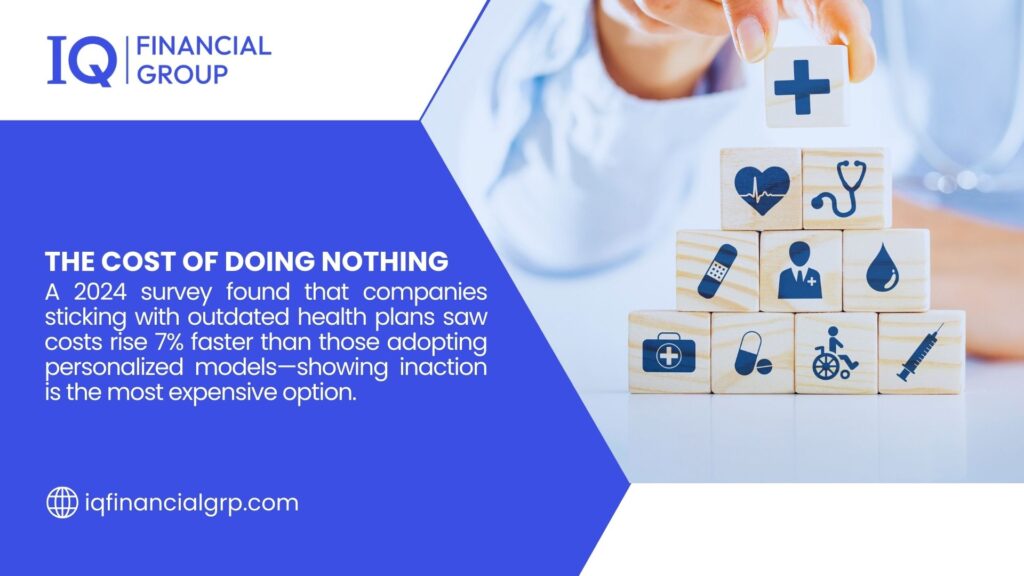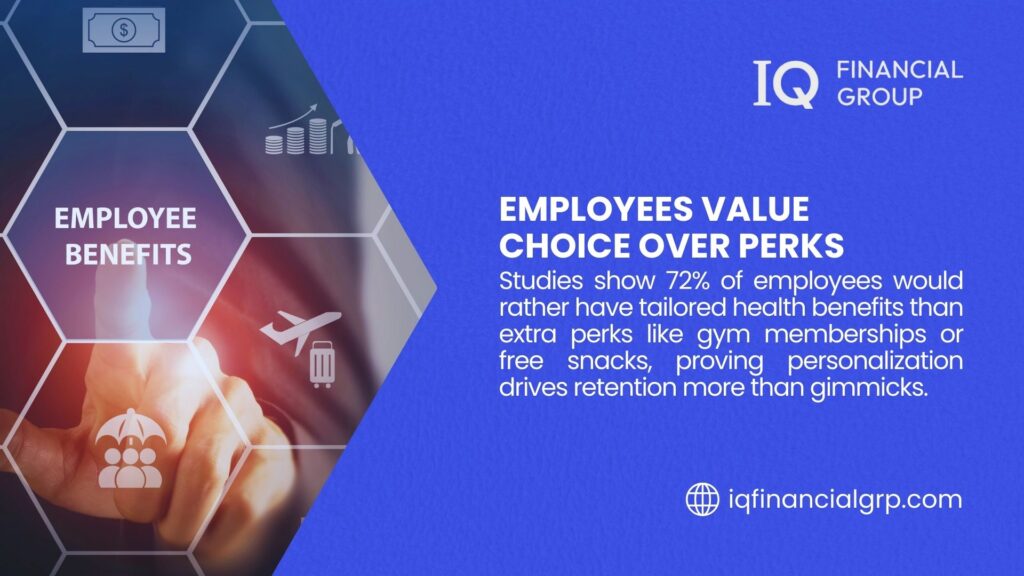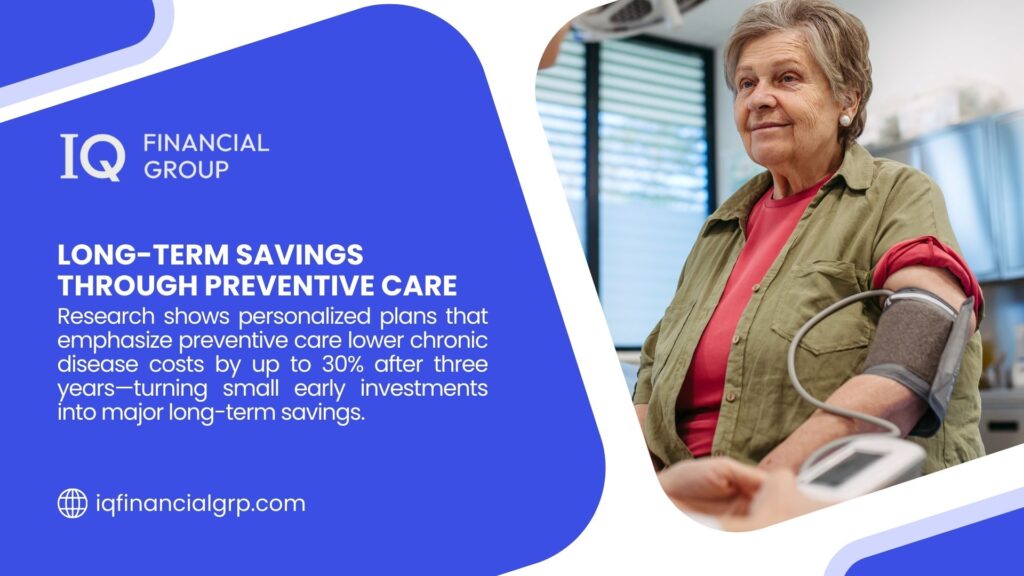Healthcare expenses are absolutely crushing businesses right now. Last year alone, companies paid an average of $25,572 for family health coverage – that’s nearly $2,000 more per employee than 2023. Individual plans weren’t much better at $8,951 annually.
88% of employers now say healthcare costs are their biggest headache. Some companies are spending more on health insurance than they do on rent. It’s gotten so bad that many business owners are seriously considering dropping coverage altogether – except they can’t because good employees won’t stay without benefits.
Why Traditional Employee Health Insurance Is Bleeding Money
Most businesses are still stuck using health insurance the same way they did in the 1990s. Everyone gets the same plan whether they’re 25 years old and healthy or 55 with diabetes.
Young, healthy employees might use $500 worth of healthcare in a year but the company pays $9,000 for their insurance. Meanwhile, someone with ongoing health issues might need $15,000 in care but gets the same $9,000 plan that doesn’t cover what they actually need.
This creates a weird situation where companies overpay for some employees and underpay for others, but somehow manage to make everyone unhappy. The healthy employees feel like they’re wasting money, and the ones who need care can’t get it covered properly.
Here’s what this looks like:
Traditional health insurance wastes about 20-25% of every dollar spent because it doesn’t match what people actually use. Add in administrative costs that are 30% higher than they need to be, and you can see why businesses are drowning in healthcare expenses.
| Problem Areas | What It Costs Companies |
| Unused benefits | 20-25% of total spend |
| Wrong coverage levels | $2,000-4,000 per employee yearly |
| Administrative waste | 30% more than efficient systems |
| Employee dissatisfaction | Higher turnover costs |
Companies keep doing this because changing seems complicated. But reducing cost with personalized health insurance for employees is actually simpler than most people think.
Smart Ways Companies Are Personalizing Health Insurance and Cutting Costs
The companies that are winning right now have stopped trying to find one perfect plan for everyone. Instead, they’re giving people options that actually make sense for their situations.
Self-funding is becoming huge for mid-sized companies. Instead of paying insurance companies a flat rate whether employees use services or not, these businesses pay for actual healthcare costs plus administrative fees. Companies with 500+ employees are saving serious money this way – often 15-20% in the first year alone.
The key is working with the right partners who understand local markets. Businesses in different areas need different approaches. A company in Los Angeles faces different healthcare costs than one in Fresno, so their insurance strategies should be different too.
Flexible benefit packages are another game-changer. Instead of one plan, employees can choose from three or four options based on what they actually need. Someone who’s healthy might pick a high-deductible plan with lower premiums. Someone with a family might want more comprehensive coverage. Some employees add vision insurance while others skip it entirely.
Using data to make decisions sounds fancy, but it’s really just common sense. Companies look at what their employees actually use for healthcare, then design benefits around those patterns. If most employees are young and rarely see doctors, why pay for premium plans? If there are several employees with chronic conditions, maybe invest in better prescription coverage.

Technology That’s Making a Difference
The technology side of personalized health insurance has gotten really good in the past few years.
AI-powered benefits platforms analyze employee data to suggest the best mix of coverage options. These systems can predict who’s likely to need more healthcare services and who won’t, then recommend appropriate coverage levels.
Digital benefits management has made it much easier for employees to understand and choose their options. The old days of confusing paperwork and benefits meetings are mostly over. Now people can log into a system, answer a few questions about their situation, and get recommendations that actually make sense for them.
Telehealth integration is probably the biggest cost-saver right now. Companies that include telehealth services are saving about $15-16 per employee per month because people use virtual visits instead of expensive emergency room trips. This adds up fast across a whole workforce.
Health Savings Accounts paired with smart planning create even more opportunities. Employees get more control over their healthcare spending while companies reduce premium costs.
The companies getting the best results from reducing cost with personalized health insurance for employees are using several of these technologies together, not just picking one and hoping it works.
How to Actually Measure If Personalized Insurance Is Working
Most companies are terrible at measuring whether their benefits changes are actually working. They switch to personalized insurance, hope for the best, and then wonder a year later if they made the right choice.
The money part is easiest to track – total healthcare costs, premiums per employee, claims ratios, and administrative expenses. Companies should see improvements within 12-18 months if they’re doing personalization right. The savings usually start small but get bigger as the program matures and more data comes in.
Employee satisfaction metrics tell a different story but are just as important. Happy employees don’t quit as often, which saves significant money on recruiting and training. Companies track things like benefit utilization rates, satisfaction survey scores, and turnover numbers related to benefits dissatisfaction.
Long-term health outcomes take longer to see but matter most for sustainability. Companies monitor preventive care usage, how well chronic diseases are managed, and overall workforce health trends. These improvements usually show up after 2-3 years but create lasting cost savings.
The smartest companies create dashboards that track all these metrics together.
| What to Measure | Expected Results | When to Check |
| Cost reduction | 10-18% savings | Every 12-24 months |
| Employee happiness | 25-40% improvement | Every 6-12 months |
| Healthcare efficiency | 15-30% better usage | Every 18-36 months |
| Admin improvements | 20-35% less work | Every 12-18 months |

Advanced Strategies for Companies Ready to Go Further
Once companies get comfortable with basic personalized insurance, there are more sophisticated approaches that can create even bigger savings and better outcomes.
Predictive analytics helps companies stay ahead of cost increases instead of just reacting to them. By analyzing claims patterns, employee demographics, and healthcare market trends, businesses can adjust their benefit strategies before problems hit their budgets.
Integrating supplemental insurance options creates more comprehensive protection without inflating core plan costs. Strategic use of products like whole life insurance or universal life insurance can provide employees with broader financial security while distributing risk across multiple insurance products.
Wellness program coordination amplifies the benefits of personalized insurance. When health benefits align with proactive wellness initiatives, companies see compound savings as healthier employees need less healthcare over time. This creates positive feedback loops that make cost reduction efforts more effective year after year.
Specialized risk management addresses situations where employees need coverage for pre-existing conditions or high-risk factors. Rather than excluding these employees or paying excessive premiums, smart companies work with specialists in high-risk life insurance to develop appropriate coverage strategies.
Healthcare Reimbursement Accounts and Tax Strategy Integration
Smart companies are discovering that modern personalized insurance works even better when combined with sophisticated reimbursement account structures and tax optimization strategies.
Health Reimbursement Arrangements have become incredibly popular because they give companies more cost predictability while offering employees more healthcare choices. Understanding what HRA structures can do for both cost management and employee satisfaction is crucial for companies considering alternatives to traditional group plans.
Tax optimization plays a bigger role than most business owners realize. Companies can leverage various tax-advantaged accounts and strategies, including approaches for how to avoid tax on savings account benefits, to create more attractive benefit packages without increasing gross costs.
Medicare supplement planning becomes important for companies with employees approaching retirement. Proper coordination with medicare supplement insurance helps manage transition costs while supporting long-term employees.
These advanced strategies require expertise to implement correctly, but they typically provide the highest return on investment for companies committed to long-term optimization of their employee benefits programs.

Let’s Make This Work for Your Business
Companies that embrace reducing cost with personalized health insurance for employees are not just saving money, they’re building stronger, more competitive organizations with healthier, happier workforces.
The challenge is that implementing these strategies correctly requires expertise that most businesses don’t have in-house. Healthcare markets are complex, regulations change frequently, and what works for one company might not work for another.
IQ Financial Group specializes in helping companies navigate this transition successfully. Our team understands how to analyze your specific situation, identify the best personalization strategies for your workforce, and implement solutions that deliver measurable results.
We work with businesses throughout California and understand the unique challenges companies face in different markets. There’s no cost for the initial analysis, and you’ll get clear information about what personalized insurance could mean for your bottom line.
For More:

